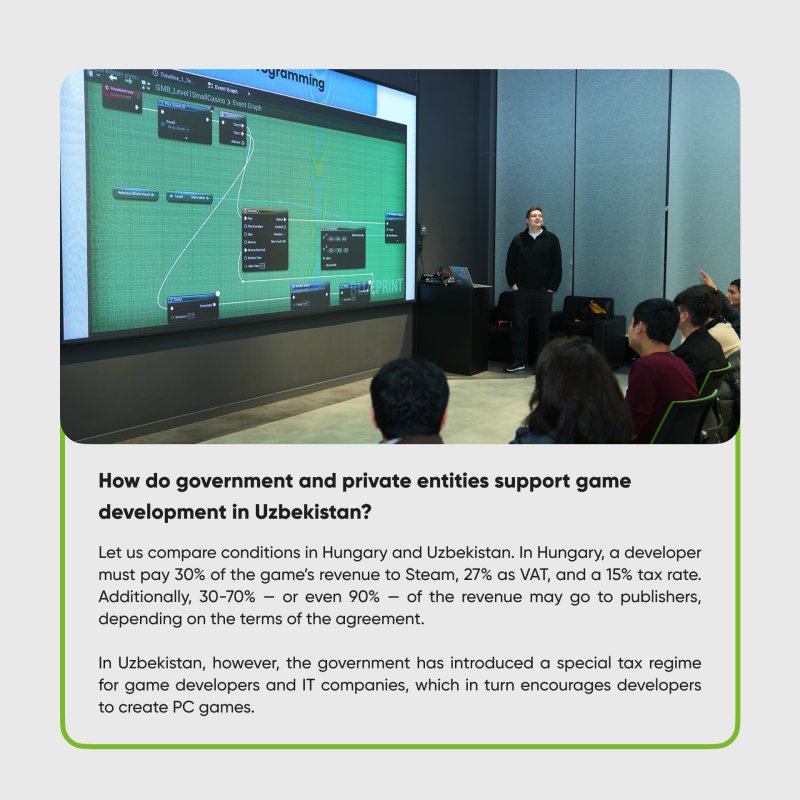
“Uzbekistan’s GameDev Boom to Begin in 2025”: Alexander Mukhitdinov on the Future of Game Development in Uzbekistan
 IT Park has initiated a new series of interviews with prominent IT sector experts, who will provide professional insights into the current market landscape, prevailing challenges, and potential solutions.
IT Park has initiated a new series of interviews with prominent IT sector experts, who will provide professional insights into the current market landscape, prevailing challenges, and potential solutions.

 In an interview with Zaryana Sorochina, he provided an overview of the current state of game development industry, the challenges developers encounter, the emergence and influence of industry trends, the indispensable skills required in game development, and more.
In an interview with Zaryana Sorochina, he provided an overview of the current state of game development industry, the challenges developers encounter, the emergence and influence of industry trends, the indispensable skills required in game development, and more.
The State of Game Development in Uzbekistan
How would you evaluate the current state of the gaming industry in Uzbekistan? What opportunities and challenges do you foresee?

 I am confident that a single skilled professional has the capacity to create a game capable of generating millions of dollars (Stardew Valley, Kenshi, Undertale are prime examples). Similarly, one competent company could revolutionize the industry, much like CD Project in Poland, which developed the groundbreaking Witcher series. This success transformed Poland into one of the foremost GameDev hubs globally.
I am confident that a single skilled professional has the capacity to create a game capable of generating millions of dollars (Stardew Valley, Kenshi, Undertale are prime examples). Similarly, one competent company could revolutionize the industry, much like CD Project in Poland, which developed the groundbreaking Witcher series. This success transformed Poland into one of the foremost GameDev hubs globally.
Following the success of The Witcher, nearly 500 development studios and publishing offices from around the world established operations in Poland, creating over 15,290 jobs. According to the European Game Developers Federation, the industry’s revenue reached €1.2 billion. Achieving similar success is entirely possible; it simply requires skilled professionals and time.
What successful GameDev projects from Uzbekistan would you highlight?
The boom in Uzbekistan’s computer GameDev sector will begin in 2025. The upcoming year will mark a major turning point for the industry, as I have observed numerous promising works from emerging developers who demonstrate remarkable potential on a global scale.
The year 2025 will be one of pioneers. One of my talented students is set to release an exceptional racing game that year. Additionally, my own multi-genre, highly original game, HitTube, which explores the world of video blogging, is scheduled for release in 2025.
What are the main challenges faced by local game developers?
There are three primary challenges. First — intense competition. The Uzbek GameDev industry competes on a global scale. An Uzbek game must contend not only with other domestic games but also with global industry giants. Steam and Epic Games Store serve as the primary platforms for distributing computer games worldwide.
The bar is set high: either succeed in global competition (including with American game developers) or fail. There is no middle ground. The main competitors are large studios with significant financial resources and independent developers who devote all their time and resources to creating their games.
Second — financing. Developing a PC game is an extremely complex and labor-intensive process. Standard development timelines range from one to five years, with costs reaching up to a million dollars. For instance, the development expenses for the game “Cyberpunk 2077” amounted to $441 mln.


Third — time. To “stay in the market”, it is crucial to play and analyze other games. However, due to the critical shortage of time that developers face, I recommend my students watch gameplay videos on YouTube to enhance their “visual literacy”.
To address these challenges, we have launched an Epic Games community: Unreal Engine Official Community – Uzbekistan (currently available only on Facebook). This is the first official Unreal Engine community in Central Asia. It serves as a platform where participants can share their work on Unreal Engine, ask questions when faced with difficulties, and seek advice from developers with extensive experience using Unreal Engine.
Trends and Technologies
Which global trends in GameDev are currently the most relevant and in demand in Uzbekistan?
According to Steam statistics, the largest volume of game purchases is concentrated in the United States and Japan. As a result, these countries establish global trends that the rest of the world follows. Trends often emerge unexpectedly and can revive previously overlooked games, even those developed years earlier. An illustrative example is Among Us, which initially experienced limited popularity but later surged due to emerging trends. Once a trend gains traction, it is typically followed by a proliferation of clone games. If you observe a significant number of new games resembling one another, it is a clear indication that a trend has been established.
What role does Unreal Engine play in the local industry?
Unreal Engine wields a considerable influence not only in the field of game development but also on cinema (e.g., utilized in The Matrix 2021), architecture, and television (notably by Fox Sport). Additionally, the South Korean virtual music group MAVE was created using Unreal Engine, and their performances are regularly broadcast on South Korean television.
CD Project, for instance, opted to develop The Witcher 4 using Unreal Engine rather than their long-standing proprietary engine. Numerous developers have made similar transitions, abandoning their traditional engines in favor of Unreal Engine for titles such as S.T.A.L.K.E.R. 2, Payday 3, and others.


Skills and Education
What key skills are essential for newcomers to successfully enter the game development industry?
The necessary skill set largely depends on the size of the company in which they aspire to work. In smaller companies, professionals must demonstrate a broad range of competencies, mastering nearly all aspects of game development. In contrast, larger organizations prioritize narrow specialization. Within such companies, there are often multiple departments, each dedicated to a specific area of development. For example, there may be an entire team solely focused on creating fur textures.
What is the optimal starting point for learning game development — studying game engines or programming?
When faced with this choice, it is advisable to begin by studying game engines. Every developer has a unique background, whether as an artist or a technical specialist, and both pathways hold equal importance. However, regardless of their area of expertise, it is imperative for all professionals to possess a thorough understanding of the game engine.
What role do artistic vision and design play in game creation?
As with books, games are often judged by their initial appearance. I oversee six curator groups on Steam (communities that provide reviews for games submitted by developers, offering positive, neutral, or negative feedback to help promote these titles among the Steam audience) and frequently receive games of various genres from developers worldwide.
One major challenge faced by certain developers is their tendency to focus exclusively on one aspect of development. While this approach may result in engaging gameplay, the graphical quality often suffers, appearing outdated and reminiscent of the early 1990s. Consequently, such games struggle to attract players.
Careers and Employment
How should an aspiring developer structure their portfolio effectively?
An exemplary portfolio should exclusively feature work that aligns with the developer’s chosen specialization (e.g., environment art). It is preferable to include a selection of 4–5 high-quality projects that you are particularly proud of.


Is remote work feasible in game development, or is relocation a necessity for involvement in large-scale projects?
Remote work is a well-established norm within the gaming industry, providing significant opportunities for local developers to secure employment with the prominent international game development studios.
Development Differences
How does game development differ from standard software development, and what specific features and nuances should be considered?
The approach varies depending on the purpose of the application or game. For instance, a calorie-tracking application designed for runners would require programming, 2D art, text localization, marketing, and a fundamental understanding of psychology to encourage sustained user engagement.
In contrast, the development of comprehensive 3D computer games represents an entirely different level of complexity. Game development is widely recognized as one of the most challenging domains within the IT industry. Creating a 3D game demands expertise in the following areas:
- 2D art (UI and logos)
- Programming
- Story writing
- Game design (encompassing psychology and sociology)
- Localization
- Marketing
- Video editing
- Music composition
- Testing
- 3D modeling (game-ready assets)
- UV mapping and unwrapping
- Lighting
- Texturing and material creation
- VFX, Optimization
- 3D animation
- Rigging and skin weighting
- Artificial intelligence.
Which roles are most in demand within game development: programmers, artists, or game designers?
The roles in highest demand are typically those that are most challenging to master, resulting in a scarcity of skilled professionals and correspondingly higher remuneration. For example, QA testers often have lower salaries due to the abundance of candidates and the minimal experience required to enter the field.
In contrast, programmers and artists must not only demonstrate technical proficiency and creativity but also compile extensive portfolios to showcase their capabilities. Their roles are indispensable to the development of a successful game. A game may be highly engaging and offer numerous features thanks to the work of programmers, but if it has unattractive, low-quality graphics, it is unlikely to attract many buyers. Conversely, even a game with stunning meshes, exceptional lighting, and high-quality animations relies heavily on the programmer’s role, as nothing would function without their input. Regarding salaries, this largely depends on the direction of the game’s development — whether the focus is more on visuals or programming.
What proportion of a development team typically consists of technical specialists versus creative specialists?
The composition of a development team depends on the genre and unique characteristics of the game. For example, simulation games (such as Hearts of Iron 4) tend to rely heavily on technical specialists, while visual novels (such as Tiny Bunny) primarily require creative specialists.
Support and Community
How do government and private entities support game development in Uzbekistan?


Furthermore, we have launched an official community with the support of the private American company Epic Games. This community brings together top specialists working with Unreal Engine. It is expected that this initiative will lead to the creation of games developed using Unreal Engine in Uzbekistan.
What educational programs and courses on game development are you planning to implement?
Our company, Cube of Skill, offers an online course on 3D computer game development using Unreal Engine. We conduct a rigorous selection process and only accept those who are genuinely focused on creating and launching their game in the global market, which, as previously mentioned, is extremely competitive. Each student independently decides the genre of their game and its unique features that set it apart from others. Based on this, a personalized training program is developed to guide them in the creation of a fully-fledged game.
Additionally, I run the “Unreal Engine Encyclopedia” on YouTube. The purpose of this encyclopedia is to provide in-depth knowledge across all aspects of game development in Unreal Engine, including materials, lighting, Blueprints, and other areas, in the most efficient manner possible. If my students face challenges in mastering any particular lesson, I create custom video tutorials for them as part of the “Unreal Engine Encyclopedia” on YouTube.
Future Outlook and Recommendations
What are the prospects for game development in Uzbekistan over the next five years?
The prospects for the industry are highly promising. It is anticipated that numerous independent game developers will emerge, creating Uzbek-made games and introducing them to the global market.
However, there is a potential, more negative scenario that must be avoided. To illustrate, let us examine the situation in India. A significant threat exists for smaller game development companies, as they may evolve into subsidiaries, working primarily on games for other countries. This is what occurred with Rockstar India, which initially served as the first independent game development company in India, only to later become a subsidiary working on foreign game projects.
This year, Rockstar India pays its testers $344 per month, whereas its parent company in Springfield, USA, compensates their testers with $2,992 per month. Despite India’s wealth of talented developers, the dominance of subsidiaries such as Rockstar India and Electronic Arts India severely limits the growth of the national game development sector, as these companies absorb all human resources.
It is essential to recognize that, while the presence of subsidiaries may provide immediate solutions to employment challenges, it will not foster the development of Uzbekistan’s game development industry. In fact, it could significantly impede the progress of local game creation. The gaming industry in a company must remain as independent as possible to replicate the success story of CD Project.

2024-12-13